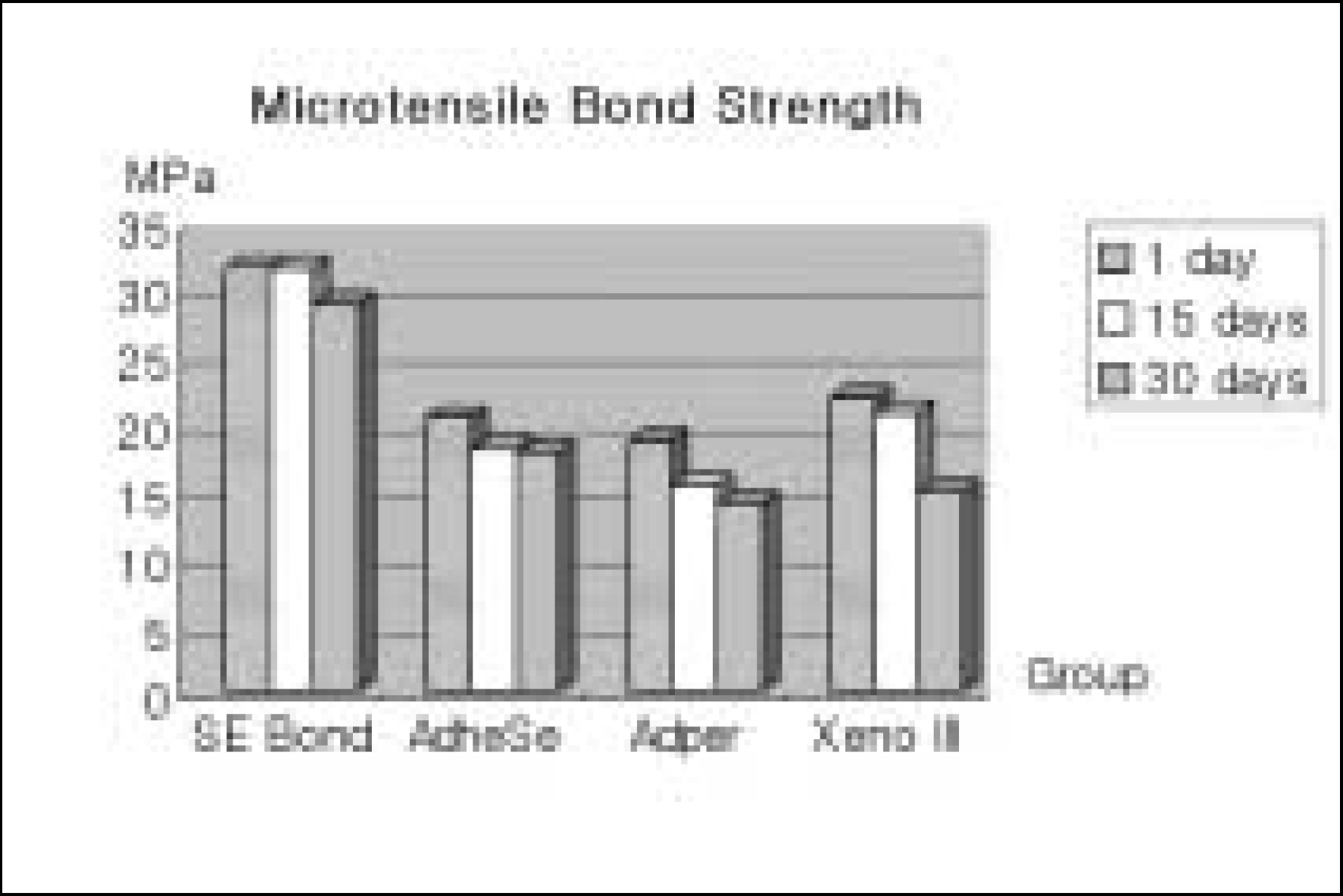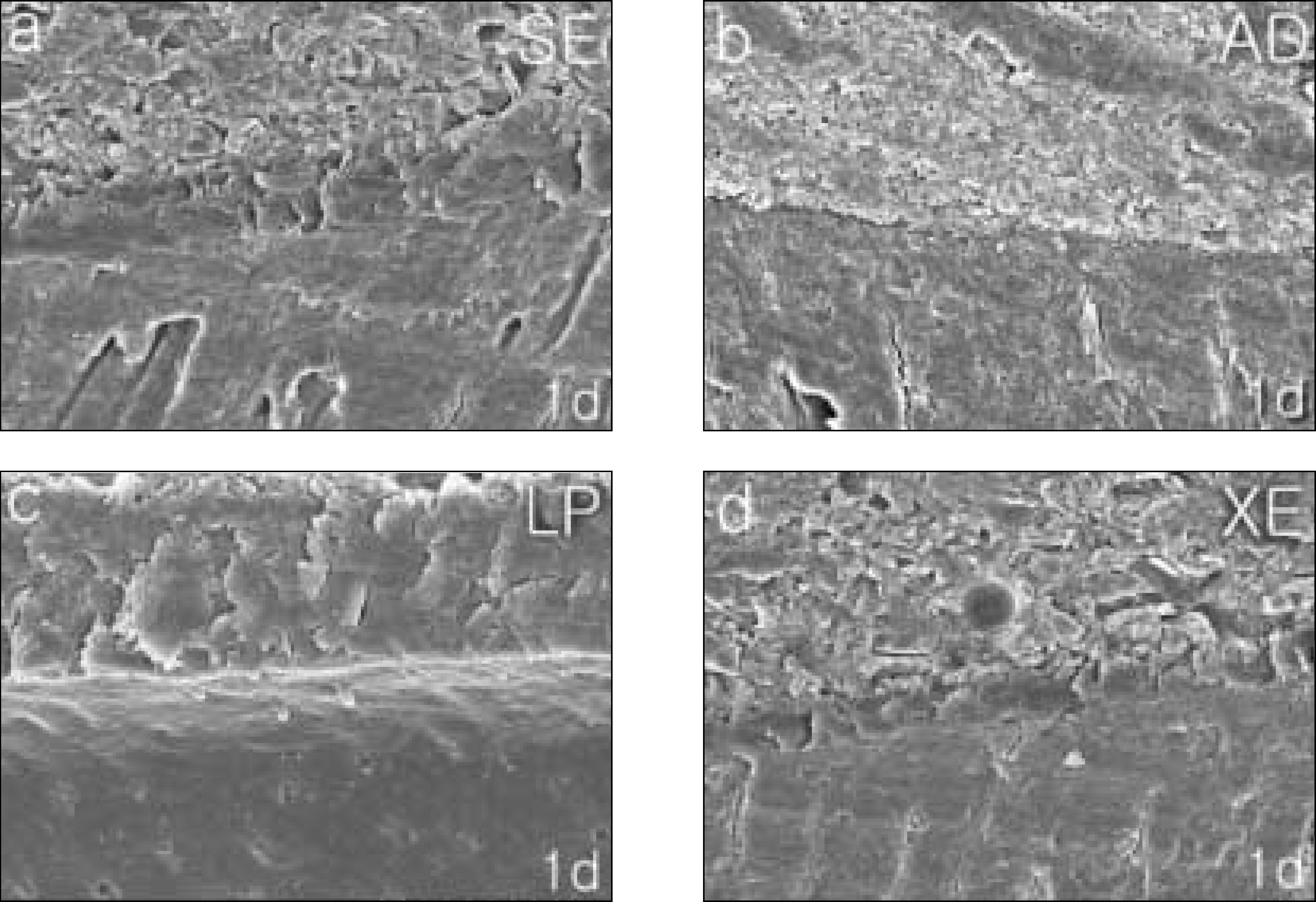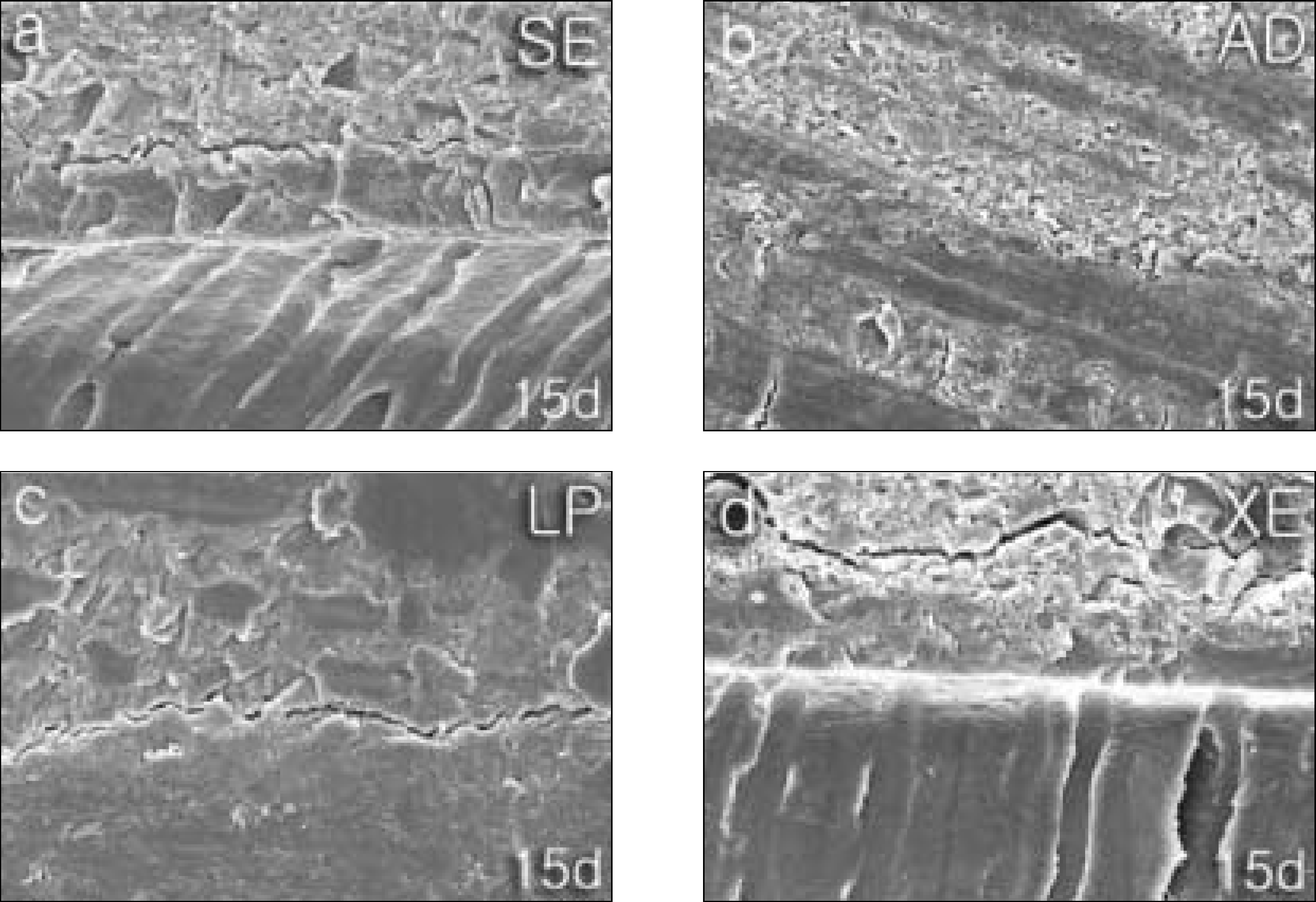ABSTRACT
This study compared the microtensile bond strength (μTBS) and microscopic change of two 2-step and two 1-step self-etching adhesives to dentin according to storage times in distilled water.
Occlusal dentin was exposed in 48 human molars. They were divided to four groups by different adhesives: SE Bond group (Clearfil SE Bond), AdheSE group (AdheSE), Adper group (Adper Prompt L-Pop), and Xeno group (Xeno III). Each group was stored in 37℃ distilled water for 1, 15, and 30 days.
Resin-bonded specimens were sectioned into beams and subjected to μTBS testing with a crosshead speed of 1 mm/minute. For SEM observation, one specimen was selected and sectioned in each group after each stroage time. Resin-dentin interface was observed under FE-SEM.
In all storage times, mean μTBS of SE group was significantly higher than those of other groups (p < 0.05). There was no significant difference between mean μTBS of SE group and AdheSE group among all storage times, but significant difference between 1- and 30-day storage in mean μTBS of Adper group and Xeno group (p < 0.05). For 1-and 15-day storage, all groups showed the close adaptation between resin-dentin interfaces. For 30-day storage, resin-dentin interfaces showed wide gap in Adper group and separate pattern in Xeno III group.
References
1. Chersoni S, Suppa P, Grandini S, Goracci C, Monticelli F, Yiu C, Huang C, Prati C, Breschi L, Ferrari M, Pashley DH, Tay FR. In vivo and in vitro permeability of one-step self-etch adhesives. J Dent Res. 83:459–464. 2004.

2. Sattabanasuk V, Shimada Y, Tagami J. The bond of resin to different dentin surface characteristics. Oper Dent. 29:333–341. 2004.
3. Okuda M, Pereira PNR, Nakajima M, Tagami J, Pashley DH. Long-term durability of resin dentin interface: Nanoleakage vs microtensile bond strength. Oper Dent. 27:289–296. 2002.
4. Tay FR, Pashley DH, King NM, Carvalho RM, Tsai J, Lai SCN, Marquezini Jr L. Aggressiveness of self-etch adhesives on unground enamel. Oper Dent. 29:309–316. 2004.
5. Armstrong SR, Keller JC, Boyer DB. The influence of water storage and C-factor on the dentin-resin composite microtensile bond strength and debond pathway utilizing a filled and unfilled adhesive resin. Dent Mater. 17:268–276. 2001.

6. Chiba Y, Miyazaki M, Rikuta A, Moore BK. Influence of environmental conditions on dentin bond strengths of one-application adhesive systems. Oper Dent. 29:554–559. 2004.
7. Pioch T, Staehle HJ, Duschner H, Godoy FG. Nanoleakage at the composite-dentin interface: A review. Am J Dent. 14:252–258. 2001.
8. Sano H, Yoshiyama M, Ebisu S, Burrow MF, Takatsu T, Ciucchi B, Carvalho R, Pashley DH. Comparative SEM and TEM observations of nanoleakage within the hybrid layer. Oper Dent. 20:160–167. 1995.
9. Guzman-Armstrong S, Armstrong SR, Qian F. Relationship between nano-leakage and microtensile bond strength at the resin-dentin interface. Oper Dent. 26:60–66. 2003.
10. Li HP, Burrow MF, Tyas MJ. The effect of thermocy-cling regimens on the nanoleakage of dentin bonding systems. Dent Mater. 18:189–196. 2002.

11. Yamauti M, Hashimoto M, Sano H, Ohno S, Carvalho RM, Kaga M, Tagami J, Oquchi H, Kubota M. Degradation of resin-dentin bonds using NaOCI storage. Dent Mater. 19:399–405. 2003.
12. Pereira PNR, Okuda M, Nakajima M, Sano H, Tagami J, Pashley DH. Relationship between bond strengths and nanoleakage: evaluation of a new assessment method. Am J Dent. 14:100–104. 2001.
13. Tay FR, Hashimoto M, Pashley DH, Peters MC, Lai SCN, Yiu CKY, Cheong C. Aging affects two modes of nanoleakage expression in bonded dentin. J Dent Res. 82:537–541. 2003.

14. Tay F, Pashley DH. Water treeing-A potential mechanism for degradation of dentin adhesives. Am J Dent. 16:6–12. 2003.
15. Li HP, Burrow MF, Tyas MJ. The effect of long-term storage on nano-leakage. Oper Dent. 26:609–616. 2001.
16. Giannini M, Seixas CAM, Reis AF, Pimenta LAF. Six-month storage-time evaluation of one-bottle adhesive systems to dentin. J Esth Rest Dent. 15:43–49. 2003.

17. Tay FR, Pashley DH, Peters MC. Adhesive permeability affects composite coupling to dentin treated with a self-etch adhesive. Oper Dent. 28:610–621. 2003.
18. Yiu CK, King NM, Pashley DH, Suh BI, Carvalho RM, Carrilho MR, Tay FR. Effect of resin hydrophilicity and water storage on resin strength. Biomaterials. 25:5789–5796. 2004.

19. Pimenta LAF, Amaral CM, Bredrane de Castro AKB, Ritter AV. Stability of dentin bond strengths using different bonding techniques after 12 months: Total-etch, deproteinization and self-etching. Oper Dent. 29:592–598. 2004.
20. Hashimoto M, Ohno H, Sano H, Kaga M, Oguchi H. In vitro degradation of resin-dentin bonds analyzed by microtensile bond test, scanning and transmission electron microscopy. Biomaterials. 24:3795–3803. 2003.

21. Okuda M, Pereira PNR, Nakajima M, Tagami J. Relationship between nanoleakage and long-term durability of dentin bonds. Oper Dent. 26:482–490. 2001.
22. Hashimoto M, Ohno H, Kaga M, Endo K, Sano H, Oguchi H. In vivo degradation of resin-dentin bonds in humans over 1 to 3 years. J Dent Res. 79:1385–1391. 2000.

23. Hashimoto M, Ohno H, Kaga M, Endo K, Sano H, Oguchi H. Resin-tooth adhesive interfaces after longterm function. Am J Dent. 14:211–215. 2001.
24. Sano H, Yoshikawa T, Pereira PN, Kanemura N, Morigami M, Tagami J, Pashley DH. Long-term durability of dentin bonds made with a self-etching primer, in vivo. J Dent Res. 78:906–911. 1999.

25. Shono Y, Terashita M, Shimada J, Kozono Y, Carvalho RM, Russell CM, Pashely DH. Durability of resin-dentin bonds. J Adhes Dent. 1:211–218. 1999.
26. Wang H, Shimada Y, Tagami J. Shear bond stability of current adhesive systems to enamel. Oper Dent. 29:168–175. 2004.
27. Paul SJ, Welter DA, Ghazi M, Pashley D. Nanoleakage at the dentin adhesive interface vs μ-tensile bond strength. Oper Dent. 24:181–188. 1999.
28. Tay FR, Pashley DH, Yoshiyama M. Two modes of nanoleakage expression in single-step adhesives. J Dent Res. 81:472–476. 2002.
29. Tay FR, King NM, Chan KM, Pashley DH. How can nanoleakage occur in self-etching adhesive systems that demineralize and infiltrate simultaneously? J Adhes Dent. 4:255–269. 2002.
30. Toledano M, Osorio R, Ceballos L, Fuentes MV, Fernandes CAO, Tay F, Carvalho RM. Microtensile bond strength of several adhesive systems to different dentin depths. Am J Dent. 16:292–298. 2003.
31. Konno AN, Sinhoreti MA, Consani S, Correr SL, Consan L. Storage effect on the shear bond strength of adhesive system. Braz Dent J. 14:42–47. 2003.
32. Hashimoto M, Ohno H, Sano H, Kaga M, Oguchi H. Degradation patterns of different adhesives and bonding procedures. J Biomed Mater Res. 15:324–330. 2003.

33. Asmussen E, Peutzfeldt A. Short-and long-term bonding efficacy of a self-etching, one-step adhesive. J Adhes Dent. 5:41–45. 2003.
34. Armstrong SR, Vargas MA, Fang Q, Laffoon JE. Microtensile bond strength of a total-etch 3-step, total-2-step, self-etch 2-step, and a self-etch 1-step dentin bonding system through 15-month water storage. J Adhes Dent. 5:47–56. 2003.
Figure 1.
Histogram showing microtensile bond strengths for each group to dentin according to storage times in distilled water.

Figure 2.
SEM photographs showing the close adaptation of dentin-resin interface produced by Clearfil SE Bond (SE), AdheSE (AD), Adper Prompt L-Pop (LP), and Xeno III (XE) after 1-day distilled water storage (× 1000).

Figure 3.
SEM photographs showing the close adaptation of dentin-resin interface produced by Clearfil SE Bond (SE), AdheSE (AD), Adper Prompt L-Pop (LP), and Xeno III (XE) after 15-day distilled water storage (× 1000).

Figure 4.
SEM photographs showing the close adaptation of dentin-resin interface produced by Clearfil SE Bond (SE) and tiny gap between dentin and resin interface produced by AdheSE (AD) after 30-day distilled water storage (× 1000).

Figure 5.
SEM photographs showing wide gap between the dentin-resin interface produced by Adper Prompt L-Pop (LP), and separate pattern between the interface of resin and adhesive layer produced by Xeno III (XE) after 30-day distilled water storage (× 1000).

Table 1.
The components and pH of two- and one-step self-etching adhesives and composites used
MDP = 10-methacryloyloxydecyl dihydrogen phosphate, HEMA = 2 hydroxyethyl methacrylate, DMA = dimethacryl-ate, Bis-GMA = Bisphenol glycidyl methacrylate, CQ = camphoroquinone, Pyro-EMA = tetramethacryloxyethyl pyrophosphate, PEM-F = pentamethacry loxyethyl cyclophophazen mono fluoride, UDMA = urethane dimethacrylate, BHT = 2,6-Di-tert-butyl-p hydroxyl toluene, EPD = p-dimethylamino ethyl benzoate.
Table 2.
Mean microtensile bond strengths (MPa) of each group to dentin according to storage times in distilled water




 PDF
PDF ePub
ePub Citation
Citation Print
Print


 XML Download
XML Download